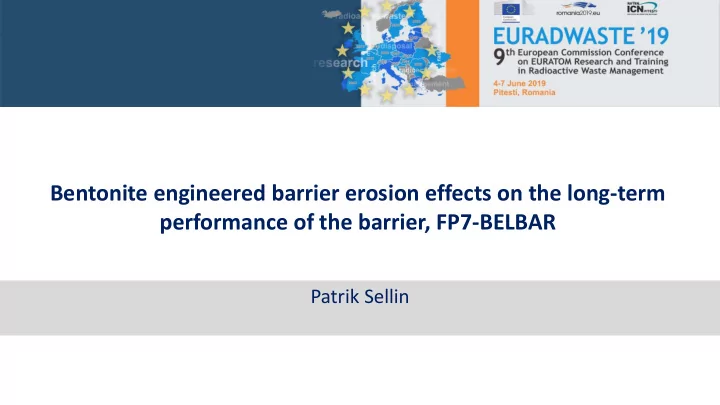

Bentonite engineered barrier erosion effects on the long-term performance of the barrier, FP7-BELBAR Patrik Sellin
BELBaR • BELBaR was a Collaborative Project within the Seventh Framework Programme of the European Atomic Energy Community (Euratom) for nuclear research and training activities. • The main aim of BELBaR was to increase knowledge of the processes that control clay colloid stability, generation and its ability to transport radionuclides. • The overall purpose of the project was to come up with a new way of treating issues in long-term safety/performance assessment. • The project started March 1, 2012 and had a duration of 48 months. – BELBaR ended February 28, 2016 • The project had 14 partners from seven European countries 2
Partners • SKB: Svensk Kärnbränslehantering, Sweden • CIEMAT: Centro de Investigaciones, Energeticas, Medioambientales y Technologicas Spain • NRI: Nuclear Research institute Rez plc, Czech Republic • KIT: Karlsruhe Institut of Technology, Germany • Posiva OY, Finland • VTT:Technical Research Instuitute of Finland • Clay Technology AB, Sweden • University of Jyväskylä, Finland • KTH: Kungliga Tekniska Högskolan, Sweden • NDA: Nuclear Decommissioning Authority, United Kingdom • B+Tech Oy, Finland • University of Manchester ,United Kingdom • Helsinki University, Finland • Lomonosov Moscow State University, Russia 3
The problem to study Bentonite Waste Fractured rock Barrier Canister
BELBaR Project WP Linkages: 5
WP4: Clay colloid stability • Clay colloid stability studies under different geochemical conditions with respect to ionic strength and pH – Reason for different behaviour of different clays - trend or correlation between the bentonites characteristics and its stability • Critical coagulation concentration, coagulation kinetics, (ir)reversibility of coagulation process – At the boundary, close to conditions which are favourable for clay colloids coagulation, the aggregation process can be very slow. – If the hysteresis of coagulation process take a place, the aggregation or disaggregation of clay colloid will not occur at the same conditions • Role of complexing agents (organic / humic substances) on clay colloid stability – Interaction between the clay colloids and organic molecules greatly influences its stability 6
Phase (state) diagram of Na-montmorillonite Seeping Fracture with Deposition Sol / Gel expanding clay hole - buffer water 7
In general, it seems like clays having more charge located in the tetrahedral layer form larger colloids: these particles sediment easier being less stable even in DW
Role of cations 8 NaCl Importance of divalent 7 KCl cations. The effect of 6 CaCl2 increasing CCC with the solid C C [mmol/L] 5 MgCl2 content (concentration of 4 bentonite in suspension). 3 2 1 0 0.01 0.1 1 10 B75 suspension [g/L] Sodium and potassium, and magnesium and calcium act in similar way during the coagulation process and in real systems (e.g. natural groundwater) their effect can be simplified to the effect of M 1+ (Na+K) or M 2+ (Ca+Mg) cations
Stability - conclusions • Above CCC a gel will form • CCC varies among Na- montmorillonites with different origins FEB 2012 • Ca-montmorillonite does not form colloids – However 20 % Na is sufficient for colloid formation • Anions have minor effect – Unless clay particle charge is influenced FEB 2014 • Organics can stabilize colloids • Attractive forces in the gels increase with aging 10
WP2: Erosion • Characteristics of the bentonite clay: role of divalent cations; other clay characteristics • Groundwater chemistry: role of divalent cations; ionic strength, mixed electrolytes • Groundwater/clay interactions: modelling inclusion in Safety Case • Groundwater velocity: dependence of erosion on water velocity • Clay extrusion paths: dependence of fracture geometry
Experimental setups flow Static system Dynamic system Flow – trough artificial fracture Chemistry Chemistry + flow Chemistry + flow + geometry 12
Erosion – results - Flow • In largely erosive systems (ion concentration well below the CCC, or erosion threshold), – the average mass loss rates seems to be (slightly) correlated with the flow velocity – The observed variability is generally within the same order of magnitude as changes in flow rate • In other cases, the water flow velocity did not seem a relevant parameter – or, at least, no clear trend between water velocity and erosion could be observed 13
BELBaR Benchmark Test Protocol Phase 1: stagnant conditions (30 days) extrusion distance Phase 2: low flow conditions (14 days at 10 -6 m/s) Phase 3: high flow conditions (14 days at 10 -4 m/s) flow effluent solids content BELBaR Final Workshop, Berlin 03.02.2016
BELBaR Benchmark Extrusion Distances
BELBaR Benchmark Summary 16
Radionuclide and host rock interactions • What are the colloid mobility controlling processes and can we describe them appropriate? • Is the sorption of strongly sorbing radionuclides fully reversible, why do we observe kinetics? • Have we indications for additional retention processes occurring? 17
Eu(III) reversibility vs. irreversibility Bulk Ligand competition experiments (EDTA) Na-Montmorillonite (Wyoming) SWy-1 • Evidence for slow release of Eu(III) from the bentonite; • Amount of ‘non - exchangeable’ Eu(III) increases with pre-equilibration time; • All systems still heading towards equilibrium.
Conclusions - Overall • The understanding of bentonite colloid stability was largely confirmed – Colloids may form under unfavorable conditions • The erosion process is difficult to describe, both conceptually and mathematically – The strong effect of gravity was a surprise • Reversibility of radionuclide sorption unto colloids was largely confirmed – However, kinetics needs to be considered 19
The research leading to these results has received funding from the European Atomic Energy Community’s Seventh Framework Programme (FP7/2007- 2011) under grant agreement no 295487. www.belbar.eu 20
Recommend
More recommend